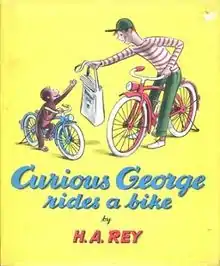Curious George Rides a Bike
Curious George Rides a Bike is a children's book written and illustrated by Margret Rey and H. A. Rey and published by Houghton Mifflin in 1952. It is the third book of the original Curious George series and tells the story of George's new bicycle and his experiences performing with an animal show.
 First edition | |
| Author | H. A. Rey Margret Rey |
|---|---|
| Country | United States |
| Language | English |
| Series | Curious George |
| Genre | Children's literature |
| Publisher | Houghton Mifflin |
Publication date | 1952 |
| Media type | |
| Preceded by | Curious George Takes a Job |
| Followed by | Curious George Gets a Medal |
Plot
To celebrate three years since he brought George home from the jungle, The Man With The Yellow Hat buys George a bicycle. George is shown doing many tricks with it, including riding backwards, and riding on the back wheel. As he's riding, he meets the local paperboy, whom he helps deliver his papers. After tossing the papers to one side of the street, he sees the road continue off somewhere he's, of course, curious about. So he rides on and doesn't deliver to the other side. He rides past a stream and sees two boys playing with boats, and decides he wants to play with boats as well, so he gets off the bike and starts folding all the papers into boats (with helpful diagrams to help the reader do the same) and set them off in the water to watch them float around. As he watches his boats float down the stream, he's still riding the bike, but because he wasn't watching where he was going, he crashed into a rock, emerging unhurt but severely damaging his front wheel. Initially not knowing what to do now (after trying to ride normally, and trying to carry the bike) he broke down crying, but then brightened up when he realized he can still ride the bike on the back wheel.
As he's doing it, he comes across the trucks carrying an animal show and its director, who fix his wheel, and decide to put George in the show as a bugle player and give him a similar coat and cap to his assistant Bob. As they set up, he tells George not to get into any mischief, and warns especially of giving anything to the ostrich. However, George (in probably the only time he truly disobeys) got too curious about that and offers his bugle to the ostrich, who snatches it and gets it lodged in his throat. The workers fight to get it out of him, then the director turns on George for not listening, takes back the coat and cap, fires him from the show, and makes him sit on a bench until he gets sent home. George is brooding over his mistake when he notices the ostrich pull a string that allows a cage door to open and a baby bear to escape. Seeing this, he grabs the bugle (which wasn't taken from him), blows a warning fanfare, then hops on his bike and takes off after the bear. At first the workers and the director thought he was misbehaving again, until they saw the empty bear cage.
By the time he catches up to the bear, it had climbed a tree, but was now hanging precariously on a branch (saying that little bears can climb up a tree easily, but getting down is much harder) scared while other workers (who chased the bear ahead of George) were standing there hoping to catch it. George gets to the tree, climbs up it, puts the bear in the empty newspaper sack he still had, and lowers him safely into the workers arms. When he gets back down from the tree, he is praised for his actions, gets the coat and cap back, and is reinstated to the show.
The whole city comes to see the show, including the paperboy, the Man, and even all the residents who never got their newspapers that day due to George. Afterwards, he is praised for his act, and got to keep not only the coat and cap, but the bugle too. The Man then takes him home to go to sleep.
Error: One inconsistency in the book is when George damaged his front wheel. Some illustrations show it with one dent, while others show it dented twice.